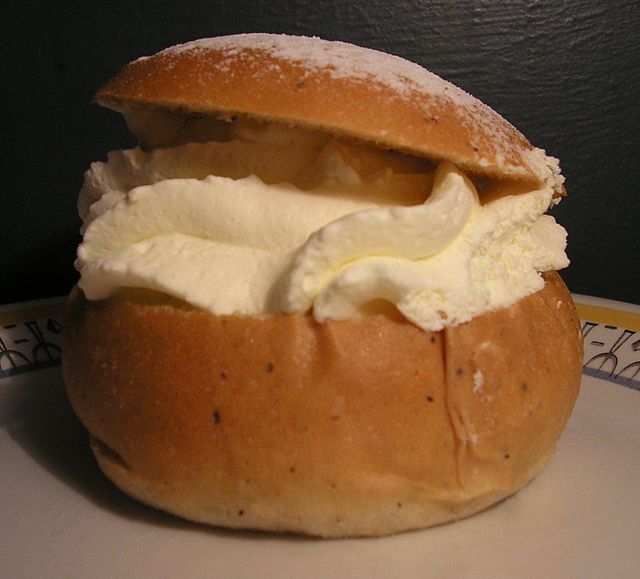A semla, vastlakukkel, laskiaispulla, Swedish eclair, fastlagsbulle/fastelavnsbolle or vēja kūkas is a traditional sweet roll made in various forms in Sweden, Finland, Norway, Denmark, the Faroe Islands, Iceland, Estonia, and Latvia, associated with Lent and especially Shrove Tuesday in most countries, Shrove Monday in Denmark, parts of southern Sweden, Iceland and Faroe Islands or Sunday of Fastelavn in Norway. In Sweden it is most commonly known as just semla, but is also known as fettisdagsbulle, lit. 'Fat Tuesday bun' or 'Shrove Tuesday bun'. In the southern parts of Sweden, as well as in Swedish-speaking Finland, it is known as fastlagsbulle. In Poland it is known as ptyś. In Estonia it is called vastlakukkel. In Norway and Denmark it is called fastelavnsbolle. In Iceland, it is known as a bolla and served on Bolludagur. In Faroe Islands it is called Føstulávintsbolli, and is served on Føstulávintsmánadagur. In Latvia, it is called vēja kūkas. Semla served in a bowl of hot milk is hetvägg.

Traditional Swedish semla
Semla served with warm milk
Two Danish fastelavnsboller
A Swedish semla
Shrove Tuesday is the final day of Shrovetide, marking the end of pre-Lent. Lent begins the following day with Ash Wednesday. Shrove Tuesday is observed in many Christian countries through participating in confession; the ritual burning of the previous year's Holy Week palms; finalizing one's Lenten sacrifice; as well as eating pancakes and other sweets.
Pieter Bruegel the Elder: The Fight Between Carnival and Lent (detail), 1559
Russian artist Boris Kustodiev's Maslenitsa (1916)
Shrove Tuesday, Bear guiding [pl] in Poland (1950)
On Shrove Tuesday, many Christians confess their sins, in preparation for Lent; depicted is an Evangelical Lutheran confessional in Luther Church (Helsinki, Finland)







![Shrove Tuesday, Bear guiding [pl] in Poland (1950)](https://upload.wikimedia.org/wikipedia/commons/thumb/4/41/Zapusty-w-Podmoklach-Wielkich_1950.jpg/640px-Zapusty-w-Podmoklach-Wielkich_1950.jpg)
